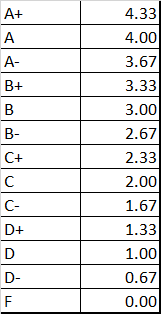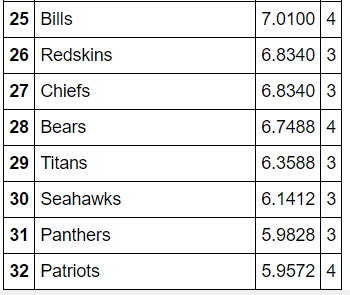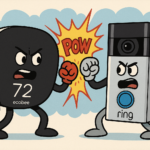I’m sure this won’t come as a surprise to anyone but the NFL draft grades have been historically off-base. I looked at Bucky Brooks NFL draft grades from 2013-2015 and how that compared to team performance. I found Bucky Brooks is very wrong.

Model Summary — iPython notebook
I first parsed through all of Bucky’s articles on NFL.com and applied the 4.0 grading scale to his grades. If Bucky gave a team A I would give the team a 4.0, B: 3.0, C: 2.0, D: 1.0, and F: 0.0. And a “+” or “-” corresponded to an increase or decrease of 0.33.

Missing data: In the case of missing data I tried a variety of approaches and settled on adding the mean of all draft grades I could find (3.05). [1]Using the team average had little affect on the results.
Discounting: To take in the effect of team performance and time since the draft grade I added a discounting factor. The 2013 draft was given more weight on current team performance than the 2015 draft. I settled on discount_factor=0.8^-(2013-draft_year)
Combination of results: I used a simple linear model of the discounted scores. score=draft_2013_score*2013_discount_factor+…+draft_2015*2015_discount_factor. Again, tweaking the discount factor had little effect on the teams grouped on the bottom. This discounting gave a range of possible scores from 0 to 9.76.
Results
In my score table I found the Seahawks, Panthers, and Patriots — currently very good teams– bringing up the rear

Towards the top I found
Interpretation and 2013 NFL Draft
Let’s compare the bottom ranked Patriots and top rated Vikings. In 2013 Bill Belichick traded for the Vikings first round pick for four draft picks however Bucky gave the Patriots a C+ and the Vikings an A+. Looking at the Patriots draft they managed to do very well considering they traded their first round pick. They got a pro bowl player out of second round pick LB Jamie Collins. 3rd round pick Duron Harmon recorded a key interception against Joe Flacco in the 2014 divisional playoff game — a season they would go on to win the Super Bowl. Another 3rd round pick Logan Ryan is now a starting cornerback. An undrafted player that year, Ryan Allen, went on to become the Patriots starting punter and he holds the record for the longest punt in Super Bowl history with 64 yards — they won that Super Bowl too.
Now let’s look at the top ranked Vikings in 2013 — Don’t forget Bill Belichick traded for the Vikings first round pick for four draft picks (including a cheaper pro bowler and key starter in the 2014 Super Bowl) . Bucky gave the Vikings an “A+” that year. In 2013 they had 3 first round picks which surely contributed to their good “grade”. Sharrif Floyd was a solid pick and has done well for the Vikings but has never been to a pro bowl and was given a large contract — large contract=bad. Xavier Rhodes, another first round pick, is a solid player but again no pro bowls and received a large contract as well. Same holds for Cordarrelle Patterson. After the first round the Vikings have only one player that remains on the team, Jeff Locke selected in the 5th round, who has a similar skill-level compared to undrafted Patriots punter Ryan Allen.
Conclusion
Bucky Brooks definitely missed the mark in 2013. The Patriots had a stellar draft and received great value at the expense of the “top ranked” Minnesota Vikings. I suspect Bucky Brooks places too much value in top round picks when the best teams win by managing cap space, coaching, and value picks. On the otherhand that wouldn’t be a good headline 😛
If you liked this piece I’d recommend you read The Signal and The Noise by Nate Silver. He’s famous for predicting the 2008 presidential election and has a blog called fivethirtyeight.com. In his book, Nate goes over conflicts of interest and basic statistical ideas applied to different fields like weather, sports, and the economy.
Feel free to comment, criticize my approach, or ask me to look into something else 🙂
References
| ↑1 | Using the team average had little affect on the results. |
|---|

